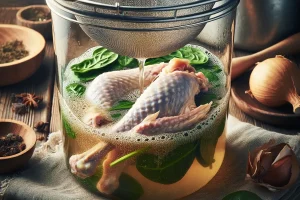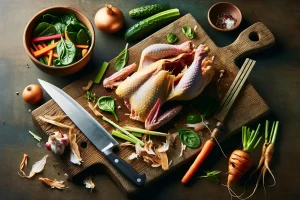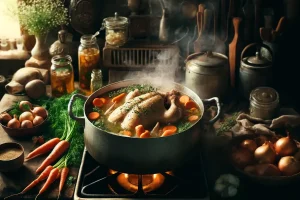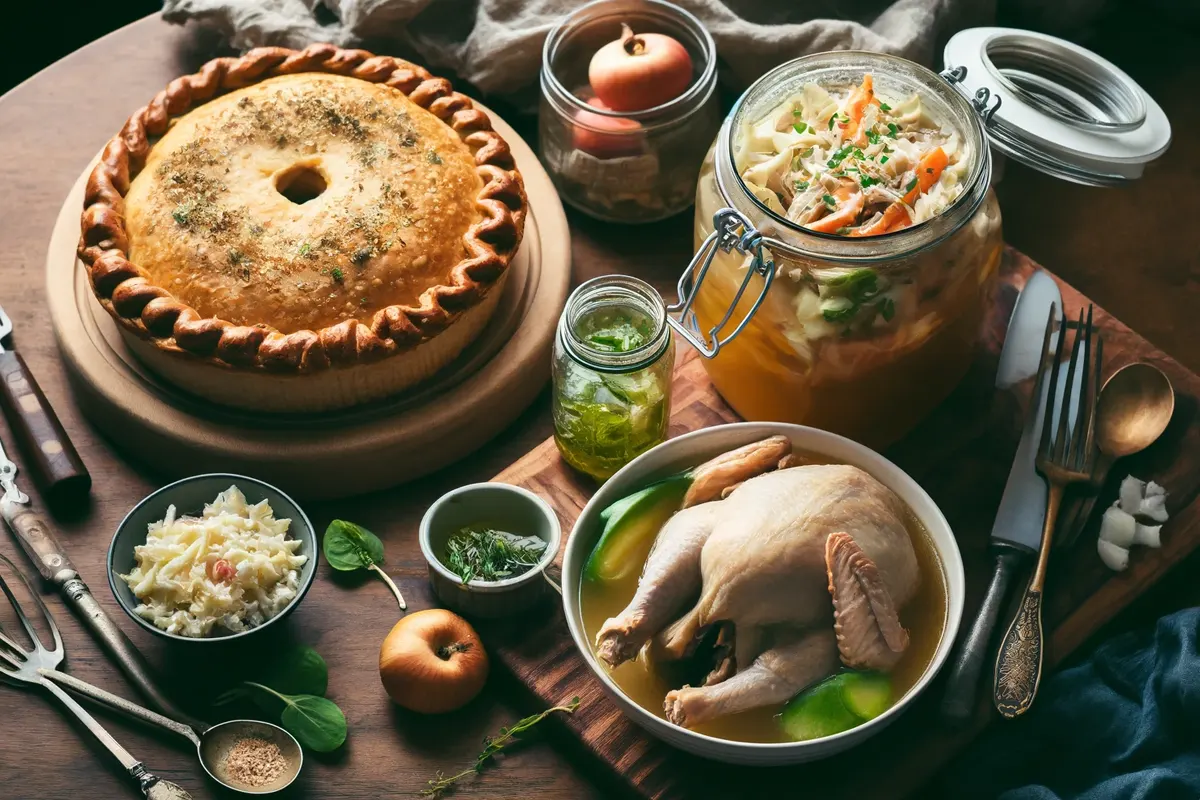In the world of culinary arts and sustainable cooking, the carcass of a chicken is not merely the end of a meal, but rather the beginning of numerous flavorful and nourishing possibilities. This article delves deep into the essence of what many might consider waste, exploring its anatomy, culinary uses, and the paramount importance of handling it with care. From crafting rich, comforting broths to adhering to stringent food safety standards, we unwrap the multitude of avenues a chicken carcass offers. As we embark on this journey, let’s embrace the ethos of nose-to-tail cooking, minimizing waste, and maximizing taste and nutrients in our kitchens.
Introduction to Chicken Carcass
Overview of Chicken Carcass
When one hears the term carcass of a chicken, images of leftover bones and scant meat might come to mind. However, in the realms of gastronomy and food sustainability, this so-called “remnant” is a treasure trove of flavors and opportunities. A chicken carcass, comprising bones, residual meat, skin, and connective tissues, serves as the backbone for some of the most foundational elements in cooking – stocks and broths. These elements not only form the base for soups and sauces but are also infused with nutrients, making them a key component of a balanced diet.
Importance of Proper Handling and Utilization
But with great flavor comes great responsibility. Handling a chicken carcass requires adherence to food safety practices to prevent contamination and foodborne illnesses. Storage, temperature control, and timely usage are critical factors that ensure the safety and quality of the dishes prepared from it. Moreover, in an era where food waste is under the microscope, utilizing the entire chicken, including the carcass, aligns with sustainable cooking practices. It’s a gesture of respect towards the food we consume and the planet we inhabit.
So, what can I do with the carcass of a chicken? The answer stretches far beyond the traditional soup pot, opening up a world of culinary creativity and environmental stewardship. Whether it’s simmering a pot of broth, innovating new dishes from leftover bones, or ensuring every part of the chicken is honored and utilized, the carcass is a testament to the endless cycle of life in the kitchen.
In the next section, we’ll peel back the layers of a chicken carcass, exploring its anatomy and the rich nutrients hidden within. Stay tuned as we uncover the building blocks of flavor and nourishment that lie in what many consider mere scraps.
Remember, proper handling of chicken, including its carcass, is crucial for health and safety. The CDC offers valuable guidelines on safe handling practices for chicken to ensure your culinary adventures are not only delicious but also safe.

Anatomy and Composition
Diving into the anatomy and composition of a chicken carcass offers a fascinating glimpse into the complexity and utility hidden within. Understanding this framework is not just for the culinary curious but also for anyone looking to make the most out of their meals, both in terms of flavor and nutrition.
Anatomical Overview
At first glance, the carcass of a chicken might seem like little more than a skeleton draped in scant remnants of meat. Yet, each bone, each piece of connective tissue, and even the skin hold potential. The bones, robust and rich with marrow, are the source of deep flavors and gelatin, a key ingredient that gives stocks and broths their luscious mouthfeel. The residual meat, often overlooked, can be tender and flavorful, perfect for shredding into dishes where it can shine anew. The skin, when simmered, contributes fat and flavor, enriching the broth. Lastly, the connective tissues dissolve into gelatin through slow cooking, adding body and richness to the liquid gold that is homemade stock.
Nutritional Value
Beyond the culinary potential, the nutritional value of a chicken carcass is notable. The bones are a source of minerals like calcium and phosphorus, essential for bone health. The marrow, hidden within the bones, is rich in iron and vitamins, particularly beneficial for boosting energy and immunity. Collagen, derived from the connective tissues and skin, is not just a culinary thickener but also a key protein for skin, joint, and gut health. Utilizing the carcass in broths and stocks not only extracts these nutrients but also makes them more bioavailable, meaning our bodies can absorb and use them more efficiently.
Incorporating the carcass of a chicken into your cooking isn’t just an act of culinary creativity; it’s a step towards a more nutritious and sustainable way of eating. By understanding and utilizing the anatomy and composition of the carcass, we can extract maximum flavor and health benefits from something that might otherwise be discarded.
In our next segment, we’ll explore the myriad culinary uses of a chicken carcass, from traditional stocks and broths to innovative dishes that breathe new life into leftover bones. The journey from carcass to cuisine is a testament to the art of cooking and the ethos of waste reduction. Stay tuned as we continue to unravel the delicious and nutritious potential hidden in the humble chicken carcass.
Culinary Uses
The carcass of a chicken is not the end of a meal but the beginning of a new culinary adventure. With a bit of creativity and traditional know-how, this often-overlooked resource can be transformed into an array of dishes that comfort, nourish, and delight. Let’s explore how the backbone of yesterday’s dinner can become the heart of today’s meal.
Stocks and Broths
The most revered use of a chicken carcass is in crafting stocks and broths, the unsung heroes of the culinary world. These liquid golds are not just about adding depth to soups and stews; they are the foundation of robust sauces, risottos, and gravies. A well-simmered chicken stock, infused with the flavors of bones, skin, and connective tissues, carries a complexity that store-bought versions often lack. It’s about gentle simmering, not boiling, which coaxes out flavors and ensures clarity in the broth. Adding aromatics like onions, carrots, and celery, along with a bouquet garni, elevates the stock, infusing it with layers of flavor that enhance any dish it graces.
Secondary Dishes
But the journey doesn’t end with liquid concoctions. The carcass of a chicken is a treasure trove for innovative secondary dishes. After making stock, the softened bones and remaining meat can be a base for pet food, ensuring our furry friends benefit from homemade goodness. The residual meat, tender and flavorful, can be shredded and added to pies, salads, or sandwiches, offering a delightful texture and taste. Even the fat skimmed from the broth can be repurposed – clarified and used for sautéing, it brings a subtle depth to a variety of dishes.
The versatility of a chicken carcass in the kitchen is a testament to the ethos of sustainability and creativity. It challenges us to look beyond the conventional uses of ingredients and explore their full potential. As we move forward, we’ll delve into the crucial aspects of health and safety guidelines that ensure the culinary uses of chicken carcasses are not only delicious but also safe and responsible.
In our culinary journey, the humble carcass of a chicken emerges as a symbol of resourcefulness, transforming from a mere leftover into the essence of soups, the base of sauces, and the heart of secondary dishes. Stay tuned as we continue to explore the art and science of making the most out of every ingredient in our kitchens.

Health and Safety Guidelines
While the carcass of a chicken offers a bounty of culinary possibilities, navigating health and safety guidelines is paramount to ensure these dishes are not only delicious but safe. Proper handling, storage, and preparation are the cornerstones of utilizing chicken carcasses without compromising food safety. Let’s delve into the best practices that every home cook should adhere to.
Handling and Storage
The journey of a chicken carcass from the dinner table to a simmering pot of stock demands careful handling to prevent the spread of bacteria such as Salmonella and Campylobacter. Always start with washing your hands thoroughly with soap and water before and after handling raw chicken. Use separate cutting boards and utensils for raw chicken to avoid cross-contamination with other foods.
Storage is equally critical. If the carcass is not to be used immediately, it should be refrigerated or frozen promptly. The USDA recommends storing cooked chicken carcasses in the refrigerator at temperatures below 40°F (4°C) and using them within 3-4 days. For longer storage, freezing is an excellent option, extending the carcass’s usability up to 4 months without significant loss of quality.
Recognizing Spoilage
Recognizing when a chicken carcass has spoiled is crucial to prevent foodborne illnesses. Signs of spoilage include an off-odor, sliminess, and discoloration. If any of these signs are present, it’s best to err on the side of caution and dispose of the carcass. Remember, when in doubt, throw it out.
The importance of these health and safety guidelines cannot be overstated. They are the linchpin in ensuring that the nutritional and flavorful potential of a chicken carcass is harnessed safely and responsibly. As we embrace the principles of nose-to-tail cooking and strive towards sustainability, being vigilant about food safety ensures that our culinary adventures are not just creative but also conscientious.
In the next section, we’ll explore the broader implications of utilizing every part of the chicken, including the carcass, in our cooking practices. From reducing waste to ethical considerations, the journey of a chicken carcass in our kitchens reflects our values and commitment to a more sustainable and respectful way of consuming food. Stay tuned as we delve into the sustainability and ethical considerations that come with nose-to-tail cooking.
Sustainability and Ethical Considerations
In the culinary world, the carcass of a chicken is more than a leftover; it’s a symbol of sustainability and ethical consumption. As we delve into the broader implications of using every part of the chicken, we find that these practices are intertwined with our commitment to environmental stewardship and ethical responsibility. Let’s explore how the mindful use of a chicken carcass reflects a deeper ethos of respect for our food and planet.
Waste Reduction
One of the most compelling arguments for utilizing the entire chicken, including the carcass, is the significant impact it has on reducing food waste. In a world where food waste contributes to environmental issues like increased greenhouse gas emissions and unnecessary depletion of resources, every small step counts. By transforming chicken carcasses into nourishing broths, inventive dishes, or even compost material, we’re not just creating delicious meals; we’re part of a larger movement towards a more sustainable food system. This practice of nose-to-tail cooking not only minimizes waste but also maximizes the value we get from our food, teaching us to appreciate and utilize every part of the ingredients we use.
Ethical Sourcing
Beyond reducing waste, prioritizing the ethical sourcing of chickens is essential when considering the whole bird, including the carcass. It’s crucial to know where and how farmers raise and process our chickens for ethical consumption. By supporting local farms committed to humane practices and sustainable farming methods, we ensure that the chickens we consume receive treatment with care and respect. This mindful sourcing approach not only improves the meat’s quality and flavor but also supports a more ethical and responsible eating ethos.
Employing the entire chicken, including the carcass, in our cooking practices is a testament to our respect for the animal and the resources it took to bring it to our table. As we embrace these sustainability and ethical considerations, we contribute to a more conscientious and sustainable food culture, one that values every part of the ingredient and seeks to minimize our ecological footprint.
In our culinary journey, the humble chicken carcass becomes a beacon of sustainability and ethical consumption, challenging us to rethink our relationship with food. As we continue to explore the myriad ways to utilize and honor every part of the chicken, we not only enrich our palates but also embrace a more respectful and sustainable way of living. Stay tuned as we further delve into the art of making the most out of every ingredient in our kitchens, fostering a culinary tradition that is as conscientious as it is delicious.

FAQs
Navigating the culinary potential of a carcass of a chicken brings up numerous questions, especially for those embarking on this sustainable cooking journey for the first time. Here, we address some of the most common queries to ensure that your venture into utilizing every part of the chicken is not only successful but also enjoyable.
Q1: How long can you keep a chicken carcass before making stock?
A1: The longevity of a chicken carcass, when stored properly, can vary. If refrigerated at temperatures below 40°F (4°C), it’s advisable to use the carcass within 3-4 days to ensure freshness and safety. For longer storage, freezing the carcass is an excellent option, extending its usability up to 4 months. Remember, when in doubt, assess the carcass for any signs of spoilage, including off-odors or discoloration, before use.
Q2: Can you reuse a chicken carcass for broth?
A2: Absolutely! A single chicken carcass can often be used to make multiple batches of broth, especially if the first extraction was done over a shorter period. The second broth might be lighter in flavor, making it perfect for more delicate soups or as a base for cooking grains. It’s a wonderful way to ensure you’re extracting as much value as possible from the carcass.
Q3: What can you do with leftover chicken bones and carcass?
A3: Beyond making nourishing stocks and broths, leftover chicken bones and carcass serve several creative purposes. You can use them as a base for pet food, giving your furry friends a homemade treat. You can also clean and dry the bones to create natural broth powders or add them to your garden compost pile as a calcium-rich supplement. The key lies in thinking creatively and sustainably to ensure you waste nothing.
Embarking on the journey of using the entire chicken, including the carcass, is not only an exploration of culinary creativity but also a step towards more sustainable and ethical cooking practices. By addressing these FAQs, we hope to empower you to make the most out of every ingredient, reducing waste and maximizing the flavors and nutrients in your cooking endeavors. Remember, the art of utilizing a chicken carcass is as much about the delicious outcomes as it is about respecting the ingredient and our environment.

